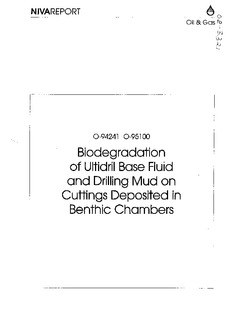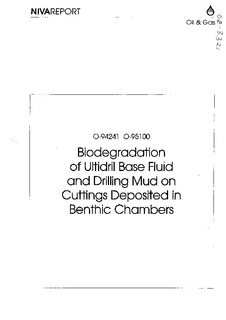| dc.contributor.author | Schaanning, M. | nb_NO |
| dc.contributor.other | Schaanning, M. - Project manager | nb_NO |
| dc.coverage.spatial | North Sea | nb_NO |
| dc.date.accessioned | 2014-08-01T10:38:22Z | |
| dc.date.available | 2014-08-01T10:38:22Z | |
| dc.date.issued | 1995 | nb_NO |
| dc.identifier | 3321 | nb_NO |
| dc.identifier.isbn | 82-577-2847-0 | nb_NO |
| dc.identifier.issn | 1894-7948 | nb_NO |
| dc.identifier.uri | http://hdl.handle.net/11250/208452 | |
| dc.description.abstract | Synthetic drilling fluids have replaced much of the mineral oil previously used in mud systems for offshore drilling operations The cmemicals are entered into the North Sea environment attached to bore hole cuttings, which are deposited on the seabed not far from the discharge sites. After deposition, erosion may occur by biodegradation, bioturbation, resuspension and release to the watermass of dissolved chemicals or metabolites. In the present investigation, aliquots of a new olefin base fluid were deposited on marine sediments in continuously flushed benthic chambers. Replicate chambers were treated with Ultidril, Petrofree and Novasol II base fluids and cuttings and non-contaminated control sediments. By the end of the experimental period, oxygen consumption could account for complete conversion of 23-80% of the added drilling fluid carbon to CO2. 0.5-38% remained present in the sediment. Half-lives ranged from 20 days for Petrofree ester, 43 days for Ultidril olefins and 127 days for Novasol II. Effects on redox potentials and macrobenthic communities were inversely related to the half-life of the drilling fluids. However, sulphide toxicity of the pore water was only observed in the chamber treated with Petrofree ester. | nb_NO |
| dc.description.sponsorship | Elf Petroleum Norge A/S Schlumberger Dowell IDF | nb_NO |
| dc.publisher | Norsk institutt for vannforskning | nb_NO |
| dc.relation.ispartofseries | NIVA-rapport;3321 | nb_NO |
| dc.rights | Navngivelse-IkkeKommersiell-DelPåSammeVilkår 3.0 Norge | nb_NO |
| dc.rights.uri | http://creativecommons.org/licenses/by-nc-sa/3.0/no/ | nb_NO |
| dc.subject | olje og gass | nb_NO |
| dc.title | Biodegradation of Ultidril Base Fluid and Drilling Mud on Cuttings Deposited in Benthic Chambers | nb_NO |
| dc.type | Research report | nb_NO |
| dc.rights.holder | Norsk institutt for vannforskning/Norwegian institute for water research | nb_NO |
| dc.subject.nsi | VDP::Matematikk og naturvitenskap: 400 | nb_NO |
| dc.source.pagenumber | 64 | nb_NO |
| dc.subject.keyword | oljeboring | nb_NO |
| dc.subject.keyword | kjemikalie | nb_NO |
| dc.subject.keyword | miljøeffekt | nb_NO |
| dc.subject.keyword | sediment | nb_NO |
| dc.subject.keyword | oil | nb_NO |
| dc.subject.keyword | drilling | nb_NO |
| dc.subject.keyword | chemical | nb_NO |
| dc.subject.keyword | environmental | nb_NO |
| dc.subject.keyword | effect | nb_NO |
| dc.subject.keyword | sediment | nb_NO |
| dc.relation.project | O-94241 | nb_NO |


